PHYSICAL SCIENCES PAPER 1 GRADE 12 QUESTIONS - NSC EXAMS PAST PAPERS AND MEMOS JUNE 2019
Share via Whatsapp Join our WhatsApp Group Join our Telegram GroupPHYSICAL SCIENCES
PAPER 1
GRADE 12
NSC EXAMS
PAST PAPERS AND MEMOS JUNE 2019
INSTRUCTIONS AND INFORMATION
- This question paper consists of 11 questions.
- Answer ALL the questions.
- You may use a non-programmable calculator.
- You may use appropriate mathematical instruments.
- Number the questions correctly according to the numbering system used in this question paper.
- You are advised to use the attached DATA SHEETS.
- The formulae and substitutions must be shown in ALL calculations.
- Give brief motivations, discussions, etc. where required.
- Round off your final numerical answers to a minimum of TWO decimal places.
- Start EACH question on a NEW page.
- All diagrams are not necessarily drawn according to scale.
QUESTIONS
QUESTION 1: MULTIPLE-CHOICE QUESTIONS
Four possible options are provided as answers to the following questions. Choose the answer and write down (A–D) next to the question number (1.1–1.10) on your ANSWER BOOK, for example 1.11 D.
1.1 A girl placed her pencil on a dashboard of a car while the car is stationary. When the car starts to move, which ONE of the following statements will be TRUE regarding the motion of the pencil?
- It will remain stationary.
- It will move forward with the car.
- It will move backwards as the car moves forward.
- It will first move forward and then backwards. (2)
1.2 A lady applied a force F on a shopping trolley and the trolley moves forward while the lady remained stationary. Which ONE of the following statements is correct?
- The force exerted on the trolley by the lady is equal to the force exerted on the lady by the trolley.
- The lady did not experience a force exerted on her.
- The force exerted on the trolley by the lady is smaller than the force exerted on the lady by the trolley.
- The force exerted on the trolley by the lady is bigger than the force exerted on the lady by the trolley. (2)
1.3 The product of the net force acting on an object and the time that the net force acts on the object is the …
- rate of change of momentum of the object.
- impulse on the object.
- momentum of the object.
- acceleration of the object. (2)
1.4 The graph below represents the velocity versus momentum of an object. 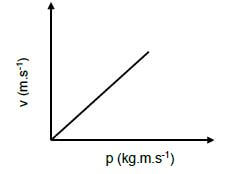
Which ONE of the following quantities is represented by the gradient of this graph?
- Impulse
- Net force
- Mass of the object
- Inverse of mass of the object (2)
1.5 Which ONE of the following acceleration versus time graphs represents the motion of a ball thrown vertically upwards to reach a maximum height after 6 s? Take upwards as positive.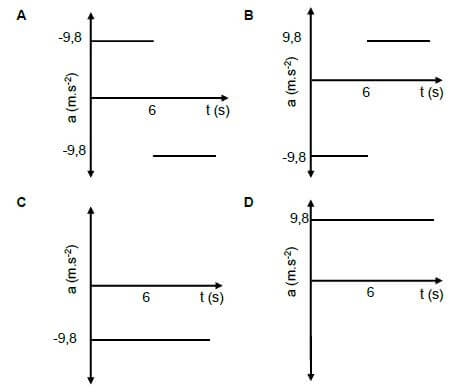 (2)
(2)
1.6 A projectile is moving upwards until it reaches its maximum height. Which ONE of the following statements is correct about the velocity?
- Velocity is zero at the maximum height.
- Velocity increases upwards.
- Velocity at maximum height is equal to velocity at point of projection.
- Velocity remain constant during its motion. (2)
1.7 Which ONE of the following statements regarding mechanical energy of an isolated is correct?
- Kinetic energy is always equal to potential energy.
- The change in kinetic energy is always equal to the change in potential energy.
- The sum of kinetic energy and potential energy is always equal to zero.
- The sum of kinetic energy and potential energy is always maximum at the maximum height. (2)
1.8 A block is moving on a horizontal surface. The work done by the gravitational force on the block is equal to zero because the …
- gravitational force on the object is equal to zero.
- gravitational force is in equilibrium with the normal force.
- angle between the gravitational force and the displacement is equal to 0°.
- angle between the gravitational force and the displacement is equal to 90°. (2)
1.9 An observer is moving relative to a stationary sound source which is emitting sound of frequency 800 Hz. As the observer moves towards the sound source, the detected frequency is 950 Hz. This observation is because the:
- Sound waves between the source and observer become compressed
- Sound waves between the source and observer become stretched out
- The amplitude of the sound waves between the source and observer increases
- The amplitude of the sound waves between the source and observer decreases (2)
1.10 The electrostatic force between two point charges which are a distance of r apart, is F. The charges are then moved to new positions such that the electrostatic force changes to 1/16F. The new distance in terms of r is …
- 4r
- 1r
4 - 8r
- 1(2) [20]
8
QUESTION 2 (Start on a NEW page.)
Two boxes, with masses of 5 kg and 4 kg, are connected by a light inextensible string passing over a frictionless pulley. The 4 kg box experiences a frictional force of 8,14 N due to the surface as it is pulled by Jane with a force of 80 N. The force applied by Jane makes an angle of 30° with the horizontal as shown in the diagram below. 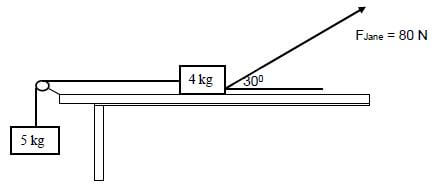
2.1 State Newton’s Second Law of motion in words. (2)
2.2 Draw a labelled free-body diagram of all the forces acting on the 4 kg box. (5)
2.3 Calculate the tension experienced in the string connecting the boxes. (5) [12]
QUESTION 3 (Start on a NEW page.)
A man of mass m, has a weight of 126,30 N on the moon. The mass and radius of the moon are 7,35 x 1022 kg and 1,74 x 103 km respectively.
3.1 State Newton’s Law of Universal Gravitation in words. (2)
3.2 Calculate the mass of the man while he stands on the moon. (4) [6]
QUESTION 4 (Start on a NEW page.)
A boy lies on a balcony of a building which is at a height h above the ground. He throws a ball vertically upwards at a velocity of 13 m.s-1. The ball reached its maximum height at the top of the building. Ignore the effects of air resistance. 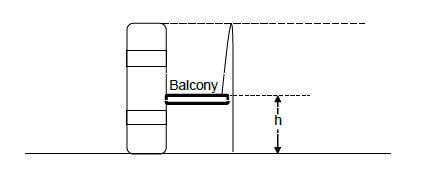
4.1 Define the term projectile motion. (2)
4.2 Calculate the time it took the ball to reach the maximum height. (3)
4.3 Calculate the magnitude of the displacement of the ball from the point of projection to its maximum height. (4)
4.4 It took the ball 3,28 s to reach ground surface from the point of projection. Calculate the:
4.4.1 Velocity with which the ball hits the ground surface (3)
4.4.2 Height of the building (6) [18]
QUESTION 5 (Start on a NEW page.)
The graph below represents the motion of a basketball ball which is dropped from a height of 8 m above the ground. The ball bounced a number of times on the ground. 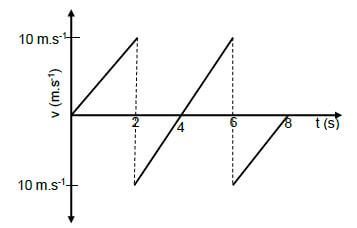
5.1 Which direction is taken as positive? (Upwards or Downwards) (1)
5.2 How many times did the ball bounce? (1)
5.3 Is the collision of the ball with the ground elastic or inelastic? (1)
5.4 At what time(s) was the ball at a maximum height after it was dropped? (2)
5.5 Draw a corresponding position vs time graph for the entire motion of the basketball from the time it was dropped.
Indicate the following:
- The height from which the ball was dropped
- The time(s) when the ball was at its maximum height (3) [8]
QUESTION 6 (Start on a NEW page.)
A traffic officer, driving a van of mass 1 500 kg at a velocity of 30 m.s-1, chased after a driver of a car of mass 1 200 kg travelling at 80 km.h-1, who did not stop at a red traffic light (robot). He accidentally hit the back of the driver’s car. After the collision the driver’s car continued to move forward at a velocity of 25 m.s-1. Ignore the effects of friction.
6.1 State the Principle of Conservation of Linear Momentum in words. (2)
6.2 Calculate the velocity of the van after collision. (5)
6.3 Calculate the change in momentum of the car. (3)
6.4 By means of calculations, determine whether the collision was elastic or inelastic. (5) [15]
QUESTION 7 (Start on a NEW page.)
Two trolleys, A and B, of masses 500 g and 750 g respectively are at rest and connected to each other by means of a compressed spring as shown on the diagram below. When the spring is released, trolley A moves at a constant velocity of 2,5 m.s-1to the left. Ignore the effects of friction. 
7.1 In which direction will trolley B move? Explain your answer. (3)
7.2 Calculate the magnitude of the velocity of trolley B. (4)
7.3 Trolley A continues to move to the left until it hits a wall at a velocity of 2,5 m.s-1. The wall exerts a net force of 21,5 N on trolley A over a period of 0,1 s. Ignore the effects of friction.
7.3.1 What is the magnitude of the net force exerted by trolley A on the wall? Explain your answer. (3)
7.3.2 Calculate the velocity of trolley A after colliding with the wall. (5)
7.3.3 An identical trolley C, of the same mass and velocity as trolley A collides with the same wall. The wall exerts a net force on trolley C in an increased contact time compared with contact time of trolley A. How will the impulse of trolley C compare with that of trolley A? Write down only INCREASE, DECREASE or STAYS THE SAME. Give a reason for your answer. (3) [18]
QUESTION 8 (Start on a NEW page.)
A steel ball of mass 0,2 kg rolls from point A to C and comes to rest at C, as shown on the diagram below. From A to B is a rough horizontal surface while from B to C it is frictionless. Point C is 1,2 m vertically above ground. 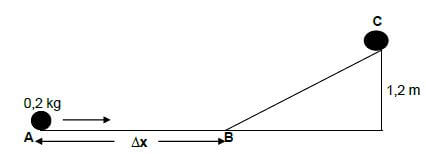
8.1 State the principle of conservation of mechanical energy in words. (2)
8.2 Use ENERGY PRINCIPLES to calculate the velocity of the ball at point B. (4)
8.3 If the initial velocity of the ball at point A is 6 m.s-1 and it took the ball 0,82 s to reach point B, calculate the distance ∆x indicated on the diagram. (3) [9]
QUESTION 9 (Start on a NEW page.)
A box, with a mass of 25 kg, is pulled with a force of 260 N up a rough inclined surface that makes an angle of 40° with the horizontal as shown in the diagram below. The coefficient of kinetic friction is 0,16 between the box and the surface. 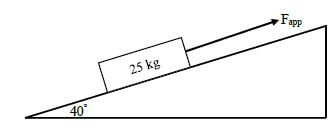
9.1 Define work-energy theorem in words. (2)
9.2 Draw a labelled free-body diagram of all the forces acting on the box. (4)
9.3 If the box started moving from rest, calculate its velocity after it had covered a distance of 8 m up the slope. (6)
9.4 Calculate the power dissipated in moving the box over a distance of 8 m. (4) [16]
QUESTION 10 (Start on a NEW page.)
10.1 Khosi detected two different frequencies, 750 Hz and 700 Hz, as he moved at constant velocity relative to a stationary ambulance which was emitting a sound through its siren.
10.1.1 State Doppler effect in words. (2)
10.1.2 Which ONE of the frequencies was detected while Khosi was moving towards the ambulance? (1)
10.1.3 Explain your answer in QUESTION 10.1.2 in terms of wavelength. (3)
10.1.4 Calculate the velocity at which Khosi was moving if the speed of sound in the air is 340 m.s-1. (6)
10.1.5 Calculate the frequency of the sound of the source. (3)
10.2 The diagrams below show two stars moving relative to each other. 
10.2.1 Is star B moving towards or away from star A? Explain your answer in terms of shift, wavelength and frequency. (4)
10.2.2 How does astronomers describe the phenomenon explained in QUESTION 10.2.1 above? (1) [20]
QUESTION 11 (Start on a NEW page.)
Two point charges of +6 μC and +4 μC are placed 200 mm apart in a vacuum.
11.1 Define electric field at a point in words. (2)
11.2 Calculate the value of x when the net electric field at point P is 1,88 x 106 N.C-1to the left. (6) [8]
TOTAL: 150
DATA FOR PHYSICAL SCIENCES GRADE 12
PAPER 1 (PHYSICS)
TABLE 1: PHYSICAL CONSTANTS
NAME | SYMBOL | VALUE |
Acceleration due to gravity | g | 9,8 m•s-2 |
Universal gravitational constant | G | 6,67 x 10-11 N•m2•kg-2 |
Speed of light in a vacuum | c | 3,0 x 108 m•s-1 |
Planck's constant | h | 6,63 x 10-34 J•s |
Coulomb's constant | k | 9,0 x 109 N•m2•C-2 |
Charge on electron | e | -1,6 x 10-19 C |
Electron mass | me | 9,11 x 10-31 kg |
Mass of earth | M | 5,98 x 1024 kg |
Radius of earth | RE | 6,38 x 103 km |
TABLE 2: FORMULAE
MOTION
FORCE
WORK, ENERGY AND POWER
WAVES, SOUND AND LIGHT
ELECTROSTATICS![]()
ELECTRIC CIRCUITS
ALTERNATING CURRENT